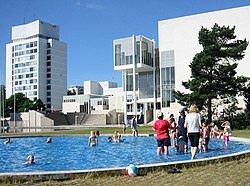Tapiola
Hagalund | |
|---|---|
 The Espoo cultural centre and the Keskustorni (central tower) | |
| Etymology: Finnish: Tapio, a forest spirit in Finnish mythology | |
 Location of Tapiola (red) within Espoo (light green) and Suur-Tapiola (dark green) | |
| Coordinates: 60°10′32″N 24°48′09″E / 60.17556°N 24.80250°E | |
| Country | |
| Municipality | |
| Region | Uusimaa |
| Sub-region | Helsinki metropolitan area |
| Main District | Suur-Tapiola |
| Inner District(s) | Itäkartano, Länsikorkee, Otsolahti, Tapiolan keskus |
| Area | |
• Total | 3.5 km2 (1.4 sq mi) |
| Population (2012)[1] | |
• Total | 9,325 |
| • Density | 2,700/km2 (6,900/sq mi) |
| Languages | |
| • Finnish | 89.9 % |
| • Swedish | 6.4 % |
| • Other | 3.7 % |
| Postal Code(s) | 02100, 02120 |
| Jobs | 7,483 |
| Website | www |
Tapiola (Finnish: [ˈtɑpiolɑ]; Swedish: ) is a district of the municipality of Espoo on the south coast of Finland, and is one of the major urban centres of Espoo. It is located in the western part of Helsinki capital region. The name Tapiola is derived from Tapio, who is the forest god of Finnish mythology, especially as expressed in the Kalevala.[2]
Tapiola was largely constructed in the 1950s and 1960s by the Finnish housing foundation and was designed as a garden city.[2] It is the location of the Espoo cultural centre, the Espoo Museum of Modern Art (EMMA), the Espoo city museum, and the Espoo City Theatre.
According to the Finnish National Board of Antiquities, Tapiola was the largest and most valuable example of the 1960s construction ideologies in Finland.[3] Its architecture and landscaping that combine urban living with nature have attracted tourists ever since.[citation needed]
- ^ Espoon asukasluku vuodenvaihteessa 2012/2013, City of Espoo, 2013, ISSN 1239-9752
- ^ a b Timo Tuomi (1992). Tapiola: A history and architectural guide. Espoo City Museum. ISBN 9518572046.
- ^ Valuable construction areas in Finland Finnish National Board of Antiquities (in Finnish)